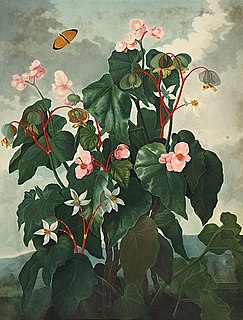
Begonia is a genus of perennial flowering plants in the family Begoniaceae. The genus contains more than 2,000 different plant species. The Begonias are native to moist subtropical and tropical climates. Some species are commonly grown indoors as ornamental houseplants in cooler climates. In cooler climates some species are cultivated outside in summertime for their bright colorful flowers, which have sepals but no petals.

The Malabar lark, or Malabar crested lark is a species of lark in the family Alaudidae found in western India.

The Karnala Bird Sanctuary is located in Panvel Taluka of Raigad District, outside Mumbai, India near Matheran and Karjat. The sanctuary is quite small with an area of 12.11 square kilometres but along with the Sanjay Gandhi National Park and Tungareshwar sanctuary is one of the few sanctuaries to be within reach of the city of Mumbai.

The chestnut-tailed starling, also called grey-headed starling and grey-headed myna is a member of the starling family. It is a resident or partially migratory species found in wooded habitats in India and Southeast Asia. The species name is after the distribution of a former subspecies in the Malabar region. While the chestnut-tailed starling is a winter visitor to peninsular India, the closely related resident breeding population with a white head is now treated as a full species, the Malabar starling.
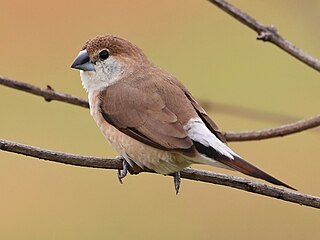
The Indian silverbill or white-throated munia is a small passerine bird found in the Indian Subcontinent and adjoining regions that was formerly considered to include the closely related African silverbill. This estrildid finch is a common resident breeding bird in the drier regions of the Middle East and the Indian Subcontinent. It has also been introduced into many other parts of the world and has become established in some areas. They forage in small flocks in grassland and scrub habitats.
Malabar may refer to the following :
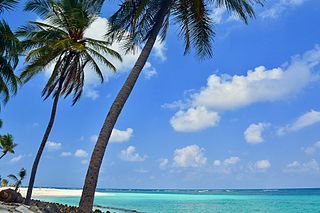
Lakshadweep is a union territory of India. It is an archipelago of 36 islands in the Arabian sea, located 200 to 440 km off of the mainland's southwestern coast.

Netravali Wildlife Sanctuary is located in South-Eastern Goa, India. It constitutes one of the vital corridors of the Western Ghats and covers an area of about 211km2. Netravali or Neturli is an important tributary of River Zuari, which originates in the sanctuary. Forests mostly consist of moist deciduous vegetation interspersed with evergreen and semi-evergreen habitat; there are also two all-season waterfalls in the sanctuary.

Madayi. is a Grama panchayat near Pazhayangadi in Kannur district, Kerala. a Bhagavathy shrine, Madayi Kavu where devotees worship Bhadrakali, is located here. The Goddess is one of the family deity of the Chirakkal Royal family, and the temple is known for the Koyikalasham. The temple was one of the few to survive desecration by the armies of Tippu Sultan, which devotees attribute to the grace of the Goddess. The Kolathiri Rajahs were the administrators of the temple, however recently the administration was transferred to the Malabar Devaswom Board. Nearby is the Vadukunnu Temple dedicated to Shiva. The temple was razed by followers of Tippu Sultan in the 18th century, but the temple has been rebuilt and is a vibrant centre of religion in the region.

Idea malabarica, the Malabar tree nymph, is a large butterfly found in peninsular India. that belongs to the danaid group of the family Nymphalidae. It is found in forest clearings and above the forest canopy.
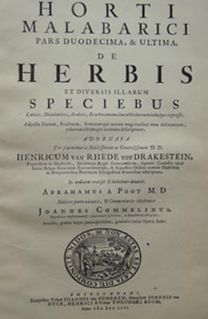
Hortus Malabaricus is a 17th-century botanical treatise on the medicinal properties of flora of the Malabar coast ). It was compiled by Hendrik van Rheede, the Governor of Dutch Malabar from 1669 to 1676. Itty Achudan, a distinguished herbalist from the ancient traditional Ezhava physicians of Kerala, was Van Rheede's key informant who disclosed the pre-Ayurvedic traditional knowledge about the plants of Malabar to him. Hortus Malabaricus was published posthumously in Amsterdam between 1678 and 1693. English and Malayalam translations of Hortus Malabaricus were published by University of Kerala in 2003 and 2008 respectively, which was largely due to the efforts of Professor K. S. Manilal, an Emeritus of the University of Calicut who devoted over 35 years of his life to research for the translation and annotation work of the original text of Hortus Malabaricus in Latin.

Kattungal Subramaniam Manilal is an Emeritus of the University of Calicut, a botany scholar and taxonomist, who devoted over 35 years of his life to research, translation and annotation work of the Latin botanical treatise Hortus Malabaricus. This epic effort brought to light the main contents of the book, a wealth of botanical information on Malabar that had largely remained inaccessible to English-speaking scholars, because the entire text was in the Latin language.

The Malabar Coast is the southwestern coast of the Indian subcontinent. Geographically, it comprises the wettest regions of southern India, as the Western Ghats intercept the moisture-laden monsoon rains, especially on their westward-facing mountain slopes. The term is used to refer to the entire Indian coast from the western coast of Konkan to the tip of the subcontinent at Kanyakumari. The peak of Anamudi, which is also the point of highest altitude in India outside the Himalayas, and Kuttanad, which is the point of least elevation in India, lie on Malabar Coast. Kuttanad, also known as The Rice Bowl of Kerala, has the lowest altitude in India, and is also one of the few places in world where cultivation takes place below sea level.

Anisomeles malabarica, more commonly known as the Malabar catmint, is a species of herbaceous shrub in the family Lamiaceae. It is native to tropical and subtropical regions of India, and Sri Lanka, but can also be found in Malaysia, Bangladesh, Myanamar, Bismarck Archipelago, Mauritius, Andaman Is. and Réunion. Growing up to 2 m high, it has narrow green leaves 3–8 cm in length, and 1.5–3 cm wide. It is pollinated by sunbirds and carpenter bees, and bears purple flowers in mid spring, though it may also bear the flowers throughout the year. Originally used in Sri Lankan and Hindi folk medicine, the current main uses are medicinal, aromatics and cosmetics.
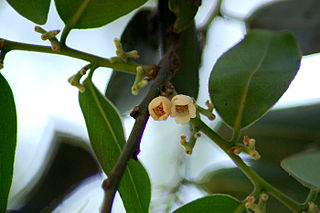
Diospyros malabarica, the gaub tree, Malabar ebony, black-and-white ebony or pale moon ebony, is a species of flowering tree in the family Ebenaceae that is native to the Indian Subcontinent and South East Asia.
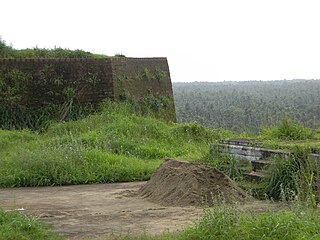
Madayipara is a flat topped hillock located in the Madayi, of Kannur district of Kerala state in the Southern India. It is overlooking Payangadi town on the northern bank of Kuppam river.

Rotala malabarica, the Malabar rotala, is a short-lived annual plant endemic to southern India, where it is known from only one location. It is considered critically endangered and may be extinct.

Begonia palmata is a species of plant in the genus Begonia of the family Begoniaceae. It is a small herb of height 20–90 cm tall. It is found in moist places, next to streams or under the shade. It is found in many parts of Asia, including eastern Himalayas.

The Malabar vine snake, is a species of tree snake endemic to the southern portion of the central Western Ghats of India.
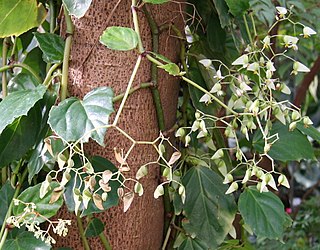
Begonia glabra, the climbing sorrel, is a species of flowering plant in the family Begoniaceae, native to the New World Tropics. An unusual vining begonia, it is popular in vivariums. Its use in the Winti Afro-Surinamese traditional religion has led to local over-collection.



















